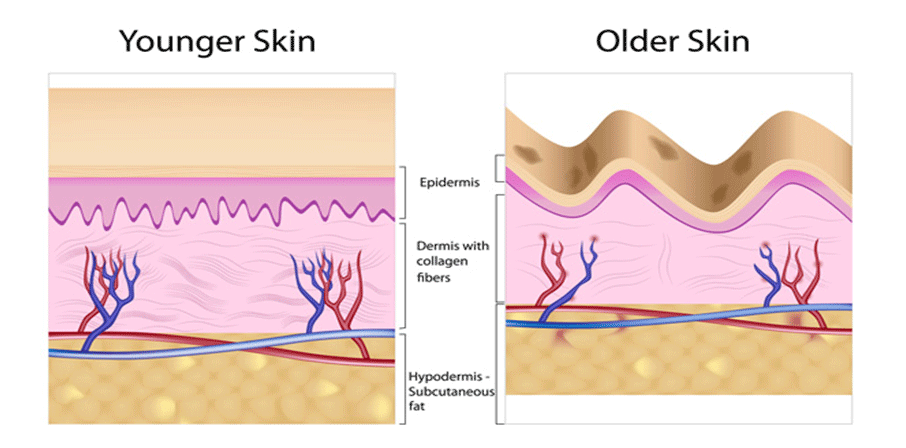What is collagen?
Collagen is a natural fibrous protein component of connective tissue. It is an insolubleextracellular glycoprotein consisting of repeating sequence of polypeptide as its basic unit. It can be found in bones, muscles and tissues of the organs.It makes up almost one third of the total body protein. It acts like a scaffold and the main building block for cells, tissues and organs which give the skin its strength, elasticity and structure.
Currently, collagen-containing product becomes more popular in Malaysia especially in beverages and drinks. Theoretically, our body can produces itself the collagen it needs. However, this production is gradually declined by aging. As a result, the skin will lose its natural elasticity and firmness. This will cause wrinkles to appear.
Researchers also revealed that women lose collagen faster than mencausing women’s skin aging faster than men. In addition, collagen is also easily degraded and resorbed by the body.
Collagen is also affected by the environmental stresses such as sun exposure, nutrition, skin damage and exposure to toxins such as pollutants, cigarette smoke and recreational drugs.
Pictures below demonstrate the presence of scaffold in older skin which contain less collagenas we grow older.
Picture 1
*However, the above diagram does not represent the usage of collagen for reversible effect of aging skin.
What is the types and sources of collagen that exist?
More than 29 different types of collagen have been described. The most common forms found in the human body are types I, II, III, and IV.
Type II collagen is the major structural component of hyaline cartilage found in synovial joints, the sternum, the respiratory tract and elastic cartilage, intervertebral discs, and the vitreous humor. Type II collagen accounts for over 50% of the dry weight of cartilage and is also found in small amounts in a number of tissues during early development. Type II collagen is a major structural protein responsible for tensile strength and toughness in the cartilage.
The table below explains types of collagen based on its sources:
|
Types of Collagen
|
Sources
|
|---|---|
| Type I | Skin, bones, tendons, ligaments and cornea |
| Type II | Cartilage |
| Type III | Take with food or milk to decrease stomach upset |
| Type IV | Basement cell membranes |
Table 1
Usage of collagen
- Usage of collagen in Traditional / Supplement category
Currently, National Pharmaceutical Control Bureau (NPCB) only approved collagen to be used with indication of to be used as a dietary supplement in Health Supplement product.
- Other usage of collagen
- For cosmetic purposes it has been injected into the dermis to correct scars and other contour deformities of the skin after usage of trichloroacetic peeling.However, limited study is available for mechanism of action fororal collagen-containing product for aging skin since collagen is a type of protein which when ingested, is broken down by the digestive system into individual amino acids to be recombined by cells according to their needs.
- Collagen implants have been used to block tear outflow in the management of dry eye.
- Intraurethral administration of collagen has been used in the treatment of stress incontinence.
- Oral Type II collagen can also be used in pain-relieving pain associated with arthritis.
How does collagen affect product classification and registration?
Nowadays, collagen becomes a more popular ingredient which is usually being formulated into beverages and drinks. It is also being incorporated into the cosmetics product. National Pharmaceutical Control Bureau (NPCB) regulates this ingredient by considering it as an active pharmaceutical ingredient which need to be registered if it is presented in Food-Drug Interphase (FDI) product with medicinal claim. However, if the collagen is formulated in FDI product without any medicinal claim, the product can be classified as non medicinal product. This type of product is regulated by Food Safety and Quality Division (FSQD)
How does this collagen being regulated in Malaysia?
Oral preparation of collagen-containing product with medicinal claim is classified as drug or specifically Health Supplement product. This type of product needs to be registered with NPCB. For cosmetic product which contain collagen and is used externally, the products need to be notified with NPCB.
References
- Clarke KI, Graves SE, Wong ATC, Triffitt JT, FrancisMJO, Czernuszka JT (1993) Investigation into theFormation and Mechanical-Properties of a BioactiveMaterial Based on Collagen and Calcium-Phosphate. JMater Sci Mater Med 4: 107-110.
- Damink L, Dijkstra PJ, van Luyn MJA, van WachemPB, Nieuwenhuis P, Feijen J (1996) In vitro degradationof dermal sheep collagen cross-linked using a water-solublecarbodiimide. Biomaterials 17: 679-684.
- Hsu F-Y, Chueh S-C, Wang JY (1999) Microspheresof hydroxyapatite/reconstitutedcollagen as supports forosteoblast cell growth. Biomaterials 20: 1931-1936
- http://cosmedmd.blogspot.com/2012/09/collagen-supplements-do-they-really-work.html
- http://loci.wisc.edu/files/loci/9D%20Vanderby.pdf Journal of Biomechanics 36 (2003) 1523–1527, Introduction to the fourth theme—the extracellular assembly of collagen, Collagen in connective tissue: from tendon to bone
- http://naturalmedicinejournal.com/journal/2013-10/effects-resveratrol-and-collagen-supplementation-facial-aging
- http://www.jaypeejournals.com/eJournals/ShowText.aspx?ID=3820&Type=FREE&TYP=TOP&IN=_eJournals/images/JPLOGO.gif&IID=298&isPDF=YES
- http://www.micromedexsolutions.com/micromedex2/librarian/ND_T/evidencexpert/ND_PR/evidencexpert/CS/D24564/ND_AppProduct/evidencexpert/DUPLICATIONSHIELDSYNC/D98E6D/ND_PG/evidencexpert/ND_B/evidencexpert/ND_P/evidencexpert/PFActionId/evidencexpert.IntermediateToDocumentLink?docId=15335-n&contentSetId=30&title=Collagen&servicesTitle=Collagen
- Kikuchi M, Matsumoto HN, Yamada T, Koyama Y, Y, Takakuda K, Shinomiya K, Tanaka J (2004a) Biomimetic synthesis of bone-like nanocomposites using the self-organization mechanism of hydroxyapatite and collagen. Compos SciTechnol 64: 819-825. 13. O’Brien FJ, Harley BA, Yannas IV, Gibson L (2004)Influence of freezing rate on pore structure in freeze-driedcollagen-GAG scaffolds. Biomaterials 25: 1077-1086
- Zhang L-J, Feng X-S, Liu H-G, Qian D-J, Zhang L, Yu X-L, Cui F-Z (2004) Hydroxyapatite/collagen compositematerials formation in simulated body fluid environment.
| Last Reviewed | : | 02 January 2015 |
| Writer | : | Nor Atikah bt. Nor Khalim |
| Accreditor | : | Salasiah bt. Abdullah |








